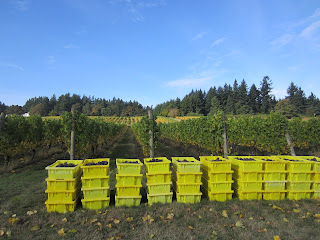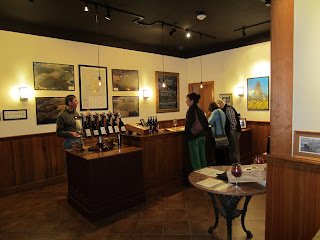I think that Alexander Payne and Jim Taylor richly deserved the Academy Award for best adapted screenplay for Sideways. Having finished Rex Picketts sequel to the novel Sideways, and seeing how poor not only his prose is, but also his proof-reading, I can only imagine how badly written his first book must have been. It's been interesting to discover what happens to the characters, and it might make an interesting film sequel. It has also proved interesting to read it as I have travelled up the west coast, following almost the same route as Miles and Jack. I have now arrived at the zenith of the novel, and the primary wine region the characters reside in. That region is the Central Otago equivalent of North America; the Willamette Valley.

Steve Naughton from Pinot NOW had given me a detailed list of wineries to visit, and over the past few weeks I had contacted most of them, and most had got back to me. Much like the rest of my trip up the coast so far, my timing was a little off as vintage was fast approaching and the much smaller wineries in the Willamette Valley were tentative to set anything up until closer to the date. They were very positive about me visiting, which was a lot more than I had gotten out of some Californian regions.
As I headed up the driveway of Evesham Wood there were small trays of freshly picked pinot gris and pinot noir sitting at the ends of rows. These were off some of the lower blocks of the estate vineyard, and up at the winery they were understandably anxious about what this record-breaking delayed harvest would provide. This is only the second vintage that the winemaker Erin Nuccio has been entirely in charge, and as was 2010 this vintage is set to be challenging. It's a very small winery built next to and under the owners house, which is now vacated since they are enjoying early retirement. Newly pressed pinot gris juice were seeping out of the bladder press, as small batches fermented in the cellar in small kegs. Several small fermenters held crushed and de-stemmed pinot noir fruit cold-soaking on skins to draw some colour before fermentation. It was far from crazy, but on the precipice. Erin was really cool and nice to spare a bit of time to chat about my trip so far and my plans. Sensing his mind was elsewhere I excused myself and hit the road.
 |
| Freshly picked pinot noir at Evesham Wood |
 |
| Evesham Wood Winery |
There was a similar feeling of trepidation around the corner at Cristom. The winemaker at Cristom is Steve Doerner, and he has a serious pinot noir background at Calera. He lamented the delayed commencement of vintage in the fact that cellar hands that had secured leave from various positions were soon to return to work, leaving him short staffed once more fruit started to come in. In the background John Farnham was playing, courtesy of the cellar hand joining them from Henshke. Steve has a very hands-off approach to his winemaking, less new oak, less maceration on skins, more whole-bunch fermentation. It is not hard to see the influence in the wines, which are very subtle, and express the site better than a lot of the wines I tried in California. It may have something to do with less intervention in the winery?..
 |
| Cellar Hands at Cristom glad to have some fruit to process |
On the same hill as Cristom sits Bethel Heights, established in 1977 by twin brothers Ted and Terry Casteel. The tasting room sits above the vineyards and has a beautiful vista, accompanied by the winery cat bathing itself. It was interesting to try the three single block pinot noirs they produce, as two of them are a Dijon clone introduced less that 20 years a go. The third block was planted to Pommard clone back in 1977 before the Dijon clone had been introduced. Comparing the three wines, the Dijon clone wines looked very tight and young, whereas the Pommard clone wine was more developed, fuller and silkier, more approachable now. They also made the best un-oaked chardonnay I have tried so far.
 |
| The Bethel Heights Winery cat |
Several people including Steve Naughton had suggested I visit Eyrie Vineyards, but I had neglected to do my research as to why. The winery and tasting room are in the town of McMinnville, and it reminded me of visiting Alsace where the wineries tend to be in the towns rather than on the estates. I soon learnt the reason why the winery was located here, as Eyrie was the first vineyard planted in the Willamette to pinot noir and chardonnay, and the first to pinot gris in the USA. The vineyards are on Dundee Hill, and in the late '60s it would have been complicated to get machinery and trucks, not to mention visitors up there.
 |
| The Eyrie Vineyards Tasting Room |
The wines made here are fascinating. They use barely any new oak, and tend to use it only on their lower priced pinot rather than the reserve. Clearly they understand that the oldest vines produce fruit that needs the least done to it in the winery. They had one pinot which was a non-vintage blend of 2006, 2007 and 2008 fruit, and was intended to raise funds for the cellarmaster's wife's kidney transplant, which as you can imagine is expensive in the States. The Reserve Estate Pinot Noir was a unique and exceptional wine, but the stand-out was the very Alsation-inspired pinot gris.
 |
| The Eyrie Reserve Pinot Noir |
I was very excited to visit the Carlton Wine Studio for two reasons. The first is that it is a co-operative winery where very small artisan producers make and exhibit their wines. The second reason is that I lived for the last three years in the Melbourne suburb of Carlton. Tasting through the pinots it was fun to see the different expressions, from different sub-regions, to different winemaking styles. One wine in particular was a deep purple colour, intense and dark but not heavy. The style of wine was reflected in the bottle; deep punt, thick heavy glass and a metallic label.
 |
| The Retour Pinot Noir at the Carlton Wine Studio |
The little I have seen so far of Portland has been excited about, and I look forward to experiencing it more over the next few days.
Click
here to see more photos from Day One in the Willamette Valley, Oregon.








No comments:
Post a Comment